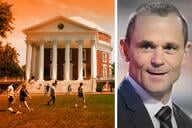You have /5 articles left.
Sign up for a free account or log in.
Sometimes our attention is so fixated on certain developments that we ignore other equally important trends.
Thus, the focus on the fall of Eastern European Communism in the late 1980s had the effect of obscuring another shift occurring in plain sight: the rise of groups like the Taliban and Al Qaeda in the Middle and Near East and of domestic terrorist groups at home.
Psychologists call this tendency perceptual or inattentional blindness: the failure to see something right in front of our faces. Blindness, in cases like these, is in our minds, not our eyes.
A somewhat similar phenomenon may well be occurring in higher education. Today, our attention tends to focus on three serious challenges:
- A demographic challenge: How best to respond to a decline in the traditional college-aged population, especially in the number of students who do not require financial aid.
- A completion challenge: How to raise graduation rates and reduce time to degree.
- An equity challenge: How to bring many more students from low-income backgrounds to a bachelor’s degree, especially in high-demand fields.
At the same time, other looming challenges threaten colleges’ business model and deserve far more attention than they currently receive.
Here are some of those “invisible” developments:
1. The blurring of the line between high school and college.
Students, in rapidly increasing numbers, are acquiring college credits in high school through early college/dual-degree programs and Advanced Placement and International Baccalaureate programs.
These programs hold out the promise of accelerating time to degree and reducing the cost of a college education, which are undeniably good things. But the effect is to reduce enrollment in gen ed courses, which, up until now, tended to subsidize smaller upper-division classes. The results: increased pressure on college business models and declining enrollment for departments dependent on service courses.
2. The emergence of new fields of knowledge and employment accompanied by shifts in student interests.
New fields of study are rapidly opening up. Here are just a few of those emerging fields: advanced manufacturing, applied acoustics, artificial intelligence, biomedicine, clean energy technology, data analytics, human-computer interaction design, materials science, nanoengineering and robotics.
Meanwhile, student demand increasingly shifts to high-cost fields of study including health care and STEM and business fields like business analytics and financial technology.
How campuses that are already financially stressed can respond to shifting student interests and the proliferation of new disciplines is one of the biggest institutional challenges of our time.
3. The need to substantially expand support services.
How can institutions meet the many support-service needs facing their students and faculty? Among those needs:
- The soaring demand for psychological and disability services.
- Faculty’s need for course design and instructional technology support.
- The challenge of implementing data-driven advising.
- The need to enlarging access to coaching, tutoring and supplemental instruction in high-demand courses with substantial DFW rates.
Providing these services at the necessary scale will require ingenuity, innovation -- and money that will likely come at the expense of existing initiatives.
4. The pressure to enhance financial support, including emergency aid.
As costs and tuition rise, as the number of full-pay students stagnates or declines, and as pressure to admit more Pell Grant-eligible and transfer students mounts, institutions must redirect more and more revenue to financial aid. Where will these funds come from?
In addition to those challenges, let me mention a few others.
- The mounting pressure to offer courses in both online and in-person modalities. Many students who work, commute, care for others or experience certain disabilities want their institutions to offer many more online options. Nothing wrong with that. At the same time, students who suffer illness or injuries would also benefit from the increased availability of remote learning. Meanwhile, asynchronous online learning also holds out the prospect of addressing the course-scheduling issues that delay graduation. Institutions find themselves on the horns of a dilemma: how to increase high-quality online offerings in a cost-efficient manner while not reducing access to in-person classes or requiring faculty to adopt a HyFlex approach to teaching.
- The need to improve postgraduation employment outcomes. In a prescient 2004 essay entitled “Vocation Is Not a Dirty Word,” Jamienne S. Studley, now the president of the regional accreditor WASC Senior College and University Commission and a past deputy under secretary in the U.S. Department of Education and Skidmore president, called for more thoughtful ways to introduce undergraduates to the world of work and weave career development across students’ educational journey. Nearly two decades later, the challenge remains, with over 40 percent of college graduates taking jobs unrelated to their degree, or that don’t even require a degree. Clearly, reliance on career services isn’t sufficient. We need to weave career development across students’ educational journey, opening windows into potential careers, offering students more career assessments and counseling, providing more job-aligned skills workshops, and expanding access to internships. But this, too, will call for redirecting existing financial resources.
- The quest for new markets. Few institutions can shrink their way to success. If colleges and universities are to thrive, they must tap new markets, whether these consist of international students, out-of-state students, transfer students, degree completers, adult learners, online learners or master’s students. In many parts of the country, competition for new students represents a zero-sum game: one institution’s gains are another’s losses. The master’s market has become increasingly problematic, as that market grows increasingly saturated, online program managers absorb a high share of revenue and mega online providers threaten to dominate the ecosystem. Worse yet, competition increasingly comes from new entrants, especially the lower-cost certificate programs offered by the like of Amazon, Google and Microsoft.
- Reimagining the student experience for a new generation of college students. The old-style student experience, organized around fraternities and sororities, intercollegiate athletics, various clubs and organizations capped by a student senate, along with various campus traditions like homecoming celebrations or campus bonfires, lingers, but for many students, this approach has lost much of its appeal. On today’s highly diverse campuses, no single student experience meets the needs of most students. Innovation is imperative.
It’s fairly obvious what needs to take place on the academic side of the house. Pace-setter institutions are instituting freshman research experiences; first-year seminars; undergraduate interest groups; makerspaces and entrepreneurship centers; expanded immersive, experiential and applied co-curricular learning opportunities; career development programming; enlarged study abroad programs; and a host of job-aligned certificates and certifications. All expensive; all needed.
What the next-generation nonacademic experience should look like is less clear-cut. Is the answer to cultivate subcommunities, organized around an arts hub; an Asian, Black or Latinx center; a business or entrepreneurship club; a transfer students center; a veterans’ center; and a women’s center, alongside targeted activities, like e-sports?
Or should institutions strive to foster a much broader sense of community through concerts and theatrical performances, expanded intramurals, international food fairs, student-faculty lunches and various campuswide wellness activities?
The obvious answer is both, but these represent yet another substantial campus expense.
- Identifying and training effective leadership. Running a college or university is like running a small (or not-so-small) city, and that, of course, is not hyperbole. Not only does every campus has its own housing, health and dining services; technology; and transportation infrastructure and sports and entertainment complexes, each has highly engaged stakeholders with very distinct interests who want to weigh in on campus priorities and decisions. The skills that a campus leader needs -- budgeting, fundraising, legal, interpersonal, strategic -- are not widespread, and the stresses that these leaders are under could scarcely be more intense. I, like you, have seen the difference that a great campus leader can make (for example, Renu Khator at the University of Houston or the late Diana Natalico at the University of Texas at El Paso). But finding those talented leaders is like searching for a hen’s tooth, and even the best burn out.
Sometimes selective attention is necessary; in the face of information overload, we must filter stimuli and focus if we are to function effectively. But just as it’s a mistake to screen out our surroundings in our personal lives, we must be careful not to allow hyperfocus to let us ignore critical developments that are emerging around us. That’s why we feel blindsided, when predictable, but ignored, eventualities bite us.
We need to take Matthew 13:13’s caution to heart: “They look, but do not see, and they listen, but do not hear or understand.”
We are told repeatedly that higher education at a crossroads or an inflection point or a critical juncture. It’s certainly true. But even as we tackle the big challenges of access, affordability, degree attainment and equity, we must grapple with other challenges that some mistakenly regard as less pressing.
After all, we can’t fix what we don’t see.
Steven Mintz is professor of history at the University of Texas at Austin.



